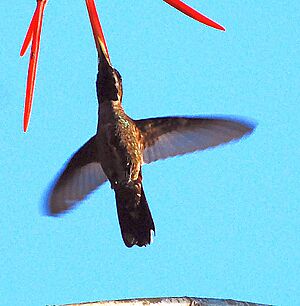Plain-capped starthroat facts for kids
Quick facts for kids Plain-capped starthroat |
|
|---|---|
 |
|
| Conservation status | |
| Scientific classification | |
| Genus: |
Heliomaster
|
| Species: |
constantii
|
The plain-capped starthroat (Heliomaster constantii) is a beautiful hummingbird found in parts of North America and Central America. It lives from Mexico all the way down to Costa Rica. These tiny birds are known for their bright colors and fast flying.
Contents
What is a Plain-capped Starthroat?
Scientists group animals to understand them better. The plain-capped starthroat is a type of hummingbird. It has three slightly different kinds, called subspecies. Think of them like different versions of the same bird. These are H. c. constantii, H. c. pinicola, and H. c. leocadiae.
How to Spot a Plain-capped Starthroat
This hummingbird is about 11 to 13 centimeters (4.3 to 5.1 inches) long. That's about the length of a pen! Males weigh around 7.4 grams (0.26 ounces), and females are a bit lighter at 7.2 grams (0.25 ounces). Both male and female birds look very similar.
What Does It Look Like?
All plain-capped starthroats have a long, straight, black beak. They also have a white stripe right behind their eye. Their feathers on top are a shiny bronze-green color. They have a wide white stripe on their lower back.
Their face is dark, with a clear white "mustache" stripe. The throat area is dark, but then it has a bright, shiny patch of feathers called a gorget. This gorget can be bright red or even purplish-red. Their belly is brownish-gray and white. They also have a fluffy tuft of white feathers on their sides.
Differences in Subspecies
The H. c. pinicola subspecies has lighter colors on its belly and a smaller red throat patch. The H. c. leocadiae subspecies has a belly color that's between the other two. Its throat patch is more pink than red.
Where Plain-capped Starthroats Live
These hummingbirds live in many different places. You can find them in dry or partly dry areas. They like the edges of forests, thorny bushes, and open areas with scattered trees.
Their Home Range
- The H. c. pinicola subspecies lives in northern Mexico, from Sonora down to Jalisco.
- The H. c. leocadiae subspecies is found in southwestern Mexico and western Guatemala.
- The H. c. constantii subspecies lives from El Salvador through Honduras and Nicaragua into northwestern Costa Rica.
Sometimes, H. c. pinicola birds fly north to Arizona in the United States. They have been seen there almost every year since 1969.
Plain-capped Starthroat Behavior
How They Move Around
Most plain-capped starthroats stay in the same area all year. However, in Sonora, Mexico, they seem to be there mostly during the breeding season. In Arizona, they are usually seen between May and October.
What They Eat
Plain-capped starthroats love to drink nectar from many different kinds of flowers. They often visit a set path of flowers, like following a map. Sometimes, male birds will even guard a patch of flowers from other birds. They can find food from the lowest plants to the tops of tall trees. Besides nectar, they also eat small insects. They catch insects by flying out from a branch or by picking them off plants.
Life Cycle and Reproduction
Not much is known about how plain-capped starthroats raise their young. In western Mexico, they breed between January and June. In Costa Rica, it's from October to January. We don't know much about their breeding times in other areas.
They build a small, cup-shaped nest. It's made of soft plant material and covered with lichen on the outside. They usually place their nest high up on a tree branch.
How They Communicate
The plain-capped starthroat has a special song. It sounds like "chip chip chip pi-chip chip chip" or "chi chi chi chi whit-it chi." They also make different calls. One call is a soft, high-pitched "tseep" or "cheek." Another is a sharp, loud "peek." When they chase other birds, they make a high-pitched, piercing twittering sound.
Plain-capped Starthroat Status
The plain-capped starthroat is doing quite well. The IUCN (a group that checks on animals) says it is a species of "Least Concern." This means it's not in danger of disappearing anytime soon.
It lives in a very large area. There are an estimated 50,000 to 500,000 adult birds. However, their numbers are thought to be slowly going down. Luckily, no big threats have been found for them right now. In some places, they are common, while in others, they are less common. Human activities probably don't have a big effect on them in the short term.


